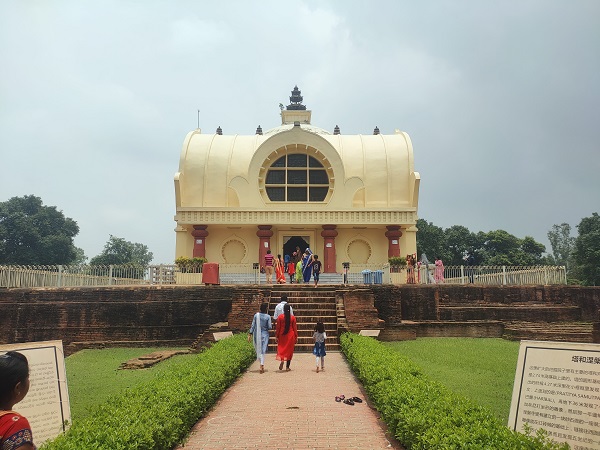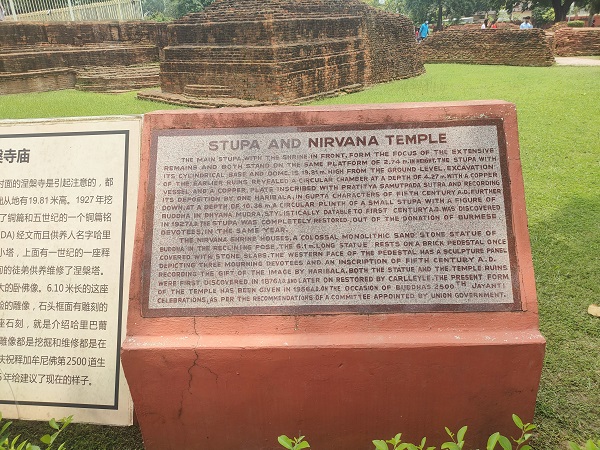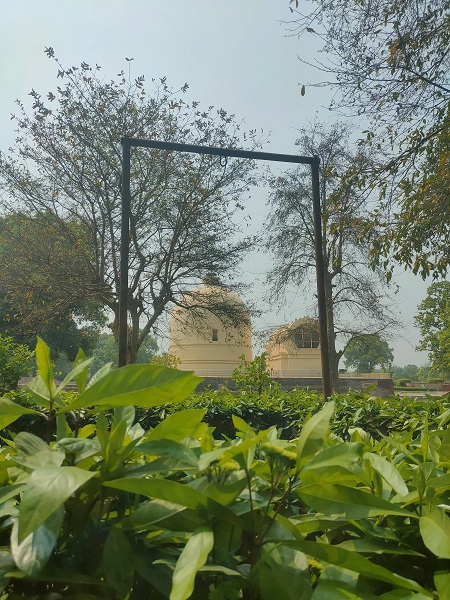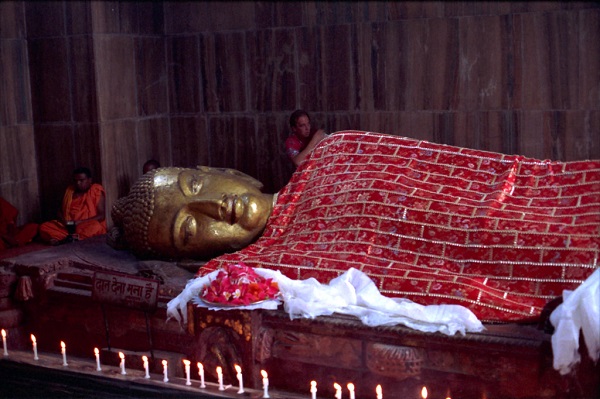The legendary history of Lord Buddha connects his life stages with different places in and around India. The conclusion to that story – or the place where he attained nirvana, is what we are going to talk about today.

History of Parinirvana temple is a conclusion to the longing journey of Gautam Buddha in search of life’s meaning and finding eternal peace.
Table of Contents
Where is the Maha Parinirvana Shrine located?
The Maha Parinirvana Stupa or temple is located in the border town of Uttar Pradesh and Bihar in Northern India. This town is called “Kushinagar” and is now proclaimed to be an International Buddhist pilgrimage center with pilgrims coming from different countries to explore and revisit the place dedicated to their Lord Buddha.

It is an easily accessible town with an International Airport and well connected road routes both from Bihar and Uttar Pradesh. It is at a distance of about 320 kilometers from Lucknow and falls on the National Highway 28.
It is the last destination pilgrims need to travel to when exploring the entire Buddhist circuit. The Buddhist Circuit is the route that basically follows the footsteps of Lord Buddha and covers places of significance of his life and learnings. These places are –
- Lumbini, Nepal – The birthplace of Siddhartha Gautam (Buddha).
- Kapilavastu, Uttar Pradesh – The place where he spent his early years in.
- Bodh Gaya, Bihar – The place where he attained Enlightenment.
- Sarnath, Uttar Pradesh – The place where he gave his first sermon or teachings.
- Rajgir, Bihar – The place where Buddha lived and taught his learnings to people.
- Kausambi, Uttar Pradesh – After the sixth and ninth year after his enlightenment, Buddha lived and preached here.
- Shravasti, Uttar Pradesh – The place where Buddha spent at least twenty four (rainy seasons) years in.
- Vaishali, Bihar – The place where Buddha gave his last sermon.
- Kushinagar, Uttar Pradesh – The place where Gautam Buddha finally attained Parinirvana (Nirvana or eternal peace after death).
Known as the final resting place of Buddha, Kushinagar is a popular tourist spot not just for the pilgrims but also for travellers and explorers interested in temple architectures as it also showcases plenty of different kinds of temples dedicated to different countries like Japan, Burma, China, Sri Lanka, Vietnam, Thailand and more.
How did Lord Buddha achieve Parinirvana?
The history of parinirvana temple cannot be described without understanding what parinirvana or nirvana actually means.

Meaning of Nirvana
Nirvana or Parinirvana is believed to be the stage of a life or a soul where it has detached itself from all the dreams, desires, fears and what not of a life cycle and the stage where the soul does not need to be reborn, a stage or space where there’s nothing left.
But achieving the final step of this “eternal peace” is mostly said to be unattainable. And can happen only after death.
Now nirvana can mean different things in different religious scriptures. In Hinduism and Jainism, the major belief is that there is a soul that exists in all living things. This soul travels through the cycle of rebirth. It is said that the soul is our real identity and this body is just a medium, right? They believe that there is an eternal soul (aatman) which after death emerges or becomes one with the universal soul (brahman or God).
But the Buddhists do not believe in this. There concept of Nirvana is different. They do not believe in the concept of an eternal soul meeting and converging into the universal soul. They believe that Nirvana is basically nothingness. A stage your soul travels through where there is nothing left.
The Great Buddhist philosopher Nagarjuna defined the term as “neti neti” which means it’s “neither this nor that” – and this is the best description of Nirvana in Buddhism. It is something which cannot be easily described or put into words and have been so for more than 2500 years now. It is just the end of all desires – of the soul, of the mind and of the body. A space where nothing’s left.
History of Buddha Achieving Parinirvana (An interesting tale of sufferings, rebirth and how to stop it)

Lord Buddha was born as a Prince in a rich kingdom, with a protective father who confined him to the palace with endless entertainment opportunities so that he never experiences sufferings. But how can a life be whole without sufferings, right?
So one day, the little prince sneaked out of the palace and saw sufferings of a sick man, an old man and a dead man.
Experiencing the sufferings of them made the prince realize that no amount of luxury or entertainment and what not can keep the sufferings away. So he began a journey to find out how to avoid suffering.
The prince now wandered through the streets leaving behind any sort of pleasures and became an ascetic. But once he figured out that not even giving up on life and the physical pleasures could avoid sufferings, that’s when it began interesting.

Lord Buddha theorized that all existence is suffering in itself. Why? Because of the concept of rebirth. He thought that the sufferings never end because the soul never stops living. He believed that after a full life of suffering people die and maybe think to themselves that at last the sufferings would vanish, but that doesn’t happen – what happens is rebirth!
So the conclusion of it all came out to be stopping the rebirth scenario. How could you stop the life cycle? How could one undo existence and stop coming back after death?
To figure and put an end to rebirth, he needed to figure out the mechanism of it first. The biggest breakthrough in understanding existence as a whole came to Buddha as the learning of the 12 links of dependent origination. (You can read more about it here.)

The 12 links of dependent origination are –
- Ignorance (Avidya)
- Voluntary Action (Samskara)
- Conditioned Consciousness (Vijnana)
- Name and Form (Nama-rupa)
- Six Senses (Sadayatana)
- Sense Impressions (Sparsha)
- Feelings (Vedana)
- Desire (Trishna)
- Attachment (Upadana)
- Becoming (Bhava)
- Birth (Jati)
- Old Age & Death (Jara-maranam)
It basically conceptualized that the cycle of rebirth and life itself and all its elements happens due to cause and effect and that everything is interconnected (like chains) in one way or another. Once you break through all these chains or links, that is when you can really achieve the impossible and stop rebirth.
In his learnings, Lord Buddha found out that karma is one thing that could cause rebirth.

Karma is basically a result of your actions and it is believed that wrong deeds of karma are all settled in the next life. Maybe that’s why we go through a rebirth? To experience what we did wrong in our previous lives? Maybe if we stop doing that and stop making karma, we could stop the cycle of rebirth?
The Buddhist concept described two elements – Enlightenment and Nirvana to stop all the sufferings and to stop rebirth. These two, although appearing to be somewhat similar in definition, are quite different.
Lord Buddha preached that there are a set of methods that needs to be done to realize that existence is suffering and the stage of enlightenment is basically the process on how one could go through all those methods one-step-at-a-time and leave all the elements of desire and life behind. The stage of enlightenment is achieved when you give up on everything – when you break all those chains that make life.
And Nirvana is the end result of these steps!
Once you walk through the steps of enlightenment, you stop making karma and work on spending all of it. And finally, when it’s all done – you have beaten the concept of rebirth!
That is what Lord Buddha learned, achieved and fulfilled in all his life travelling from place to place. And he taught about it wherever he went.
And finally, in Kushinagar, Gautam Buddha achieved complete or Parinirvana.
But, Why Kushinagar?
Why did Lord Buddha choose Kushinagar as the place of achieving Maha Parinirvana?
When Lord Buddha and his disciples came to Kushinagar, Buddha rested between two pairs of unusually tall Sala trees in a lion posture with his head facing the north.

That’s when Buddha was asked “Why Kushinagar?” To which he answered – “Due to three reasons.“
- Kushinagar was perfect venue to teach Maha-Sudassana Sutta.
- An arhat (someone who achieved enlightenment) named Subhadda who still needed to be given the Lord’s teachings.
- A wise and respected old Brahman called Doha. (who could later mediate among all the Buddha disciples and Kings who would be arguing about the holy preachings)
Once all these reasons were fulfilled, finally the Lord rested at the place which is now known as the Maha Parinirvana Temple in Kushinagar. The enigmatic modern shring was constructed by Pandit Nehru while the large golden statue of Lord Buddha in a sleeping or resting position which the shrine houses was established at the place by the monk Haribhadra centuries ago.
Conclusion

That concludes the blog about the History of Parinirvana Temple of Lord Buddha in Kushinagar. I hope you found the history as interesting as I did. The concept of life, suffering, death, rebirth is really interesting and fascinating to me and many others. That’s what makes the tale more unique and attractive.
I hope you liked the blog, if you did please share it with your friends and family. If you want to suggest a blog post for the future you may comment down below!
That’s all folks!





Well the travel related content is good but there is lot of misconception related to concept of NIRAVANA. Nirvana can be achieved only during life cycle and not after death, meaning of Nirvana is dissolution of the mind and the destruction of the ego. Soul or Atman doesn’t take birth or rebirth, it’s the ego tendency that takes birth or rebirth. Atman is eternal. When the mind is free of thoughts and is absolutely pure then that which is eternal comes into being and this state cannot be described as the experience and the experiencer merges. These things I can say as I have read few spiritual scriptures of Hinduism and Buddhism
Thanks for the comment. I learnt by visiting the place there’s two different aspects to it – Nirvana and Parinirvana. I talk here about Parinirvana (which is described as complete Nirvana – that happens only after death). I appreciate your information, though. Thanks for reading.
That’s really interesting history and the way you explain it like a story makes it more interesting , I learned many things from your blog. Keep sharing blog like this
Glad you liked it <3
Amazed to know the complete history behind Kushinagar Temple.I belong to the place but still no one ever explained it as your blog did.Keep it up and keep spreading the knowledge.
Glad you liked it ❤️